How Beer is made
The Carlsberg production process, from fermentation and pasteurisation to bottling and kegging strictly adheres to guidelines and quality control standards set out by Carlsberg Breweries International. Carlsberg breweries worldwide are all governed and constantly monitored by on-site Quality Control Sections, established to ensure that the beer produced is always of the highest standards and of a uniform quality and taste.
Beer Production Step by Step
Carlsberg and Leon are brewed in a natural brewing process, with no additives. They contain water, barley malt, hops, and the unique Carlsberg and Leon yeasts for the fermentation in the brewing process.
Carlsberg and Leon have a policy of not using GMO raw materials.
Following the tabs below, you may discover the whole process of beer making, from the selection of raw materials to brewing, fermenting and packaging at the Cyprus Carlsberg Brewery.
-
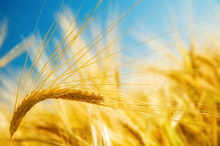
Malt
Malt is produced from barley which has been germinated for a limited period of time and then dried normally followed by a slight roasting. The malt represents the source of carbohydrates, degraded proteins, vitamins and quite a few enzymes. In order to assure malt of good quality it is necessary that the barley used is of good quality and that the appropriate malting conditions are applied. Only special varieties of barley are suitable for beer production. Malt barley is one of the most important raw materials used in the production of beer.

Hops
Hops come from a climbing plant with male and female flowers. Only the female flowers are used. It is hops that give beer its characteristic traditional bitterness. The degree of bitterness of the beer depends on the hop rate. Different varieties, ranging from very bitter to aromatic, are used to contribute to the flavour and aroma of each beer.
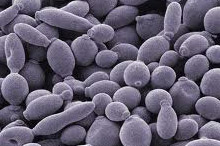
Yeast
Yeast is a single-celled micro-organism which reproduces rapidly by dividing. It is added to the process to convert the sugars of the wort into alcohol and carbon dioxide by fermentation. Breweries develop their own strains of yeast and preserve them very carefully.
The use of pure yeast culture developed by Emil Christian Hansen in 1883 at Carlsberg’s Central Research Laboratories in Copenhagen was a significant technological advance which made it possible to control the process of fermentation. Carlsberg begun, in 1883, as the first brewery in the world, to use pure yeast cultures.
Water
In terms of quantity, this is the major raw material. Approximately 90% of the final product is water. It is a very important ingredient of beer. The quality of the brewing water has a significant effect on flavour.
-
The first stage of the brewing process is the preparation of the wort.
Milling
In the brewhouse the malt is first steeped with water and then crushed in the mill to a grist of suitable fineness to form a mash. Care should be taken during crushing to make sure the husk are not damaged, since they are used as filter bed for separating the spent grains from the wort during Lautering.

Mashing
The mash is pumped to the mash tun where is heated, following a pre-set time-temperature programme, in order to convert and dissolved substances from the malt in the brewing water. During mashing, the malt enzymes break down the starch to sugars and proteins into amino acids, which are essential for the yeast. Factors such as temperature, pH, and length of time of the mashing must be carefully controlled so as to create optimum conditions. The substances dissolved in the water are collectively called “extract” and the solution formed is called the “wort”.
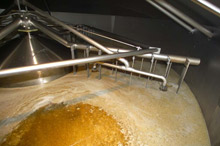
Wort separation – Lauter tun
When the mash is completed, the spent raw materials, called the “spent grains”, are separated from the wort in the lauter tun through a porous filter bed formed by the husks. The residual extract in the filter bed is leached out with sparging water. The “spent grains” are removed to the spent grains tank and sold as cattle feed.

Wort boiling
Following removal of the spent grains, the wort is transferred to the wort kettle. The wort is then boiled with hops releasing bitter substances and oils which are dissolved in the wort.
During wort boiling all enzymes are inactivated to prevent the continued breakdown of proteins during fermentation. The wort is sterilised. Bittering of wort occurs via isomerisation of hop alpha-acids. Unstable colloidal protein coagulates and precipitates (the trub). Unwanted flavour compounds evaporate from the wort. The wort is concentrated.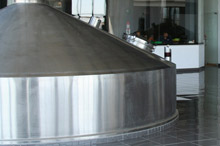
Wort Clarification – Whirlpool
After wort boiling, the wort proceeds to the Whirlpool where the precipitate (the trub) obtained during the boiling process are separated from the wort. The wort should be clear and free of particles before entering the fermenting vessel. Particles carry lipids which in high concentration have a marked influence on the formation of other flavour components from yeast during fermentation.
Wort cooling
After clarification, the hot wort is cooled passing through a plate heat exchanger. The hot water produced is collected and used as brewing water.
-

Fermentation
Once the hot wort has been cooled to the fermentation temperature, it is transferred to the fermentation tank. During this transportation process, yeast and sterilised air (oxygen) are added to assist fermentation.
Oxygen is necessary to support development of the yeast to a state and amount capable of fermenting wort efficiently.
During fermentation the yeast metabolises the fermentable sugars of the wort, forming alcohol and carbon dioxide.
Heat is generated during fermentation. To maintain the desire fermentation temperature, the fermentation vessel must be cooled.
The carbon dioxide generated during fermentation process is collected, cleaned, and then reused in the brewery.
When the fermentation is completed, the yeast is cropped and transferred to the yeast storage tanks. Now, for the first time, the liquid is called beer.
During fermentation, yeast is produced in excess. A part of this yeast is reused for a new batch of wort, the remainder being discharged and treated as a by–product.Beer clarification and cooling
Once the fermentation process is completed, the beer is pre-clarified passing though a centrifuge to remove any yeast remnants and is then cooled at a temperature of about -1.5oC. The cooling of beer prior to filtration is important in regard to self life, since a forced precipitation of haze particles takes place at this stage rather than later in the bottle.

Beer Filtration
After cooling, the beer is filtered to obtain the specified low levels of initial haze in the beer and to facilitate prolonged self life. It passes through a kieselguhr (diatomaceous earth) filter following by a sheet filter.
In order to achieve the finished product specification for CO2, the beer is carbonated before being sent to the bright beer tank.
When the filtration process is completed, the filtered beer is transferred to the bright beer tanks, ready for packaging. -
From the bright beer tanks the beer is pumped to the packaging area, where it is bottled, canned or kegged.
 The empty crates enter the bottling plant where they are removed from the pallets by an automatic depalletiser. They then pass a visual inspection where foreign object, if present, are removed and broken or crowned bottles are discharged.
The empty crates enter the bottling plant where they are removed from the pallets by an automatic depalletiser. They then pass a visual inspection where foreign object, if present, are removed and broken or crowned bottles are discharged.
Then the crates go to a decrating machine and the bottles are taken out of their crates. The empty bottles go to a bottle washing machine where they are consecutively washed in water and caustic soda solution, and rinsed three times with clean water.The bottles go through electronic control to detect and remove those unlikely cases where bottles have not been properly cleaned, contain foreign objects or have a broken neck.
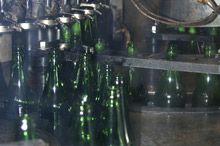 Once the bottles have been checked they enter the filler where the air is removed and carbon dioxide pressure added before they are filled with beer from the bright beer tanks . The absence of oxygen in the bottle ensures the beer retains its fresh taste for a long time.
Once the bottles have been checked they enter the filler where the air is removed and carbon dioxide pressure added before they are filled with beer from the bright beer tanks . The absence of oxygen in the bottle ensures the beer retains its fresh taste for a long time.After the filling machine, the crown is affixed to the bottle. Between filling and crowing the beer is forced to release some carbon dioxide. This lead to slight frothing which in turn displaces any air which may have entered the bottle after the filler.
The filled bottles are checked electronically to ensure that they have the right amount of beer.
Pasteurisation follows in order to ensure that the beer is protected from micro-organisms which may alter its taste. Pasteurisation guarantees the beer’s quality and taste.
The labels are attached by an automated labelling machine. Labels are placed on the bottle neck, on the front body and on the back body. The back label also contains the best before date.
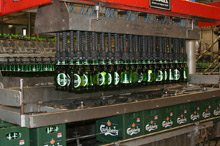 The filled bottles go through a further electronic control to check there has been no leakage between pasteurization and labelling.
The filled bottles go through a further electronic control to check there has been no leakage between pasteurization and labelling.Then the filled bottles are placed in the clean crates by the crater.
Finally a paper cover is placed on the top and the filled crates are stacked on pallets automatically, ready for the consumer.








